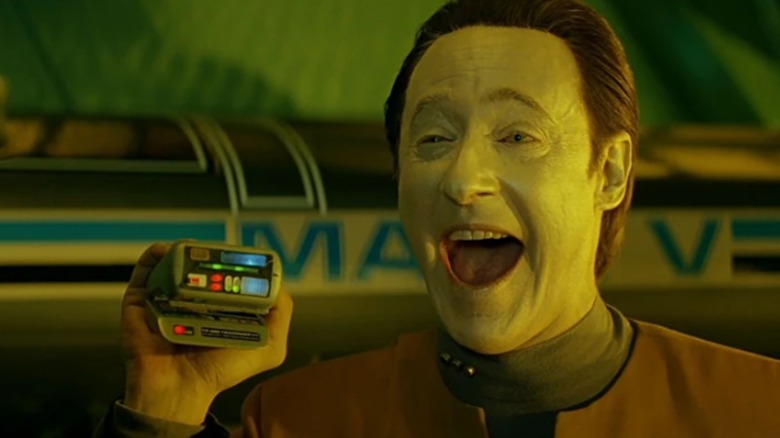How Does A Star Trek Tricorder Actually Work?
The ultimate space travel multitool, a "Star Trek" tricorder is one of the handiest things aboard any Starfleet vessel. Useful for performing a wide range of functions, they are the "Star Trek" universe's answer to a smartphone. And like the mobile phone, these handy devices see quite a few evolutions through the years from the early bulky models on "Star Trek: The Original Series," eventually getting the ultimate 32nd century holographic interface as seen in "Star Trek: Discovery." As Bradward Boimler put it, "They never improved the design. Sure, they were made smaller, and more powerful, and less likely to explode" ("Star Trek: Lower Decks: Those Old Scientists").
As described in the "Star Trek: The Next Generation Series Bible (Season One)," tricorders are "portable scanning devices" that are "capable of scanning and recording information about alien landscapes, cities and objects." According to the 1967 "Star Trek Writer/Directors Guide." the "tri-" refers to the device's three primary capabilities as part sensor, part computer, and part recorder, all packaged neatly in a portable device. This handy piece of equipment is useful for much more than planet scanning on away missions and can function equally as means of recording communications or medical data.
Although the 1967 writers' guide explicitly states that the tricorders' functionality should never be explained in the series, the 1977 "Star Trek Star Fleet Medical Reference Manual" takes a pretty solid stab at tricorder engineering. Written by a group of fans — three of whom would end up working on "Star Trek" productions — and based on information mined from the series, the guide states that tricorders were built upon Dr. Richard Daystrom's duotronics technology. According to the manual's diagrams, earlier medical tricorders featured a scanner display, speaker/microphone, remote scanner, analysis section, surgical tools, and controls for analyzing, recording, and diagnosing.
The tricorder was designed for Yeoman Rand
Although the tricorder would eventually come to be an invaluable tool in the Starfleet universe, it started out as a plot device meant to increase the relevance of the ship's yeoman in "The Original Series," according to a production note revealed in "The Making of Star Trek." Sent from "Star Trek" creator Gene Roddenberry to producer Robert H. Justman on April 14, 1966, the note considered ideas for expanding Yeoman Janice Rand's (Grace Lee Whitney) role, writing, "It has been suggested that she carry as part of her regular equipment [...] some sort of neat, over-the-shoulder recorder-electronic camera via which she can take log entries from the Captain at any time, make electronic moving photos of things, places, etc." (p. 169). In the same note, Roddenberry suggested a second use for this type of equipment: as a toy for "female-type children."
Those simple functions would soon be expanded to include the tricorder's three main functions. According to the "Star Fleet Medical Reference Guide," the "diagnose" function of the medical tricorder works almost exactly as the sick bay scanner would right down to the vital signs readout. "Analyze" allows users to evaluate information in more detail, ascertaining details like what type of bacterial organism they are dealing with or taking a much closer look at blood composition. And "record" allows users to record that data.
Although the tech would eventually change in-universe, Yeoman Rand's model would have a lasting impact on generations of Starfleet officers to come. Just as humans today often wax nostalgic over their favorite vintage technology, trill Starfleet officer Jadzia Dax (Terry Farrell) revealed how much she admired the classic design of the 23rd century model in the "Star Trek: Deep Space Nine" episode "Trials and Tribble-ations."

